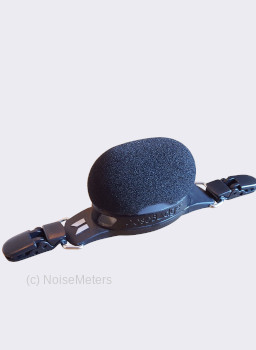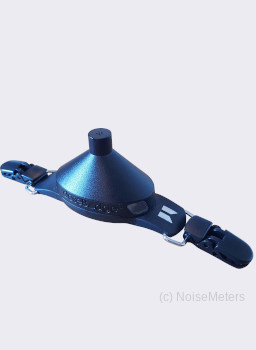



The delivery price is calculated during checkout based on your location and the goods ordered. Our basic delivery prices are:
Delivery within Ireland: €27.00
Delivery Service: Three working days*
* For products that are in stock and the order received by midday.
Some products go through a final configuration and calibration before being shipped. If the calibration labs are busy this can add up to two days on to the delivery schedule but guarantees a fresh calibration.
The doseBadge Professional is a high specification noise dosimeter for monitoring a worker's exposure to high noise levels in the workplace. It mounts on a worker's shoulder in order to measure the total noise exposure throughout the working day or shift. This Professional version makes all the measurements of the lower cost Industrial doseBadge but adds a number of useful features for a deeper analysis of the sound levels, better measurement control and more detailed reporting.
The doseBadge Pro can be configured to comply with any occupational noise regulations, standards or guidelines. As it has four independent channels or integrators, it can be configured to meet multiple regulations at the same time.
For regulations such as OSHA in the USA, the doseBadge Pro can be set up to measure to both OSHA HCA and OSHA PEL at the same time. Maybe even add an ISO (3dB) channel so you have historic measurements in case the OSHA regulations change at some time!
The doseBadge Industrial is a slightly lower cost noise dosimeter that offers the functions required by the regulations, but of course doesn't have many of the advanced features offered by the Professional.
The following features are only available in the Professional version:
The doseBadge Pro is a noise dosimeter that mounts on the worker's shoulder, attached to the clothing with two clips, to measure the noise levels throughout the day.

The measurement process can be started (see the Using It tab) and left running for the duration of the work shift.
The battery in the doseBadge Pro is charged using the Docking station. From flat it takes about three hours to fully charge a doseBadge. One docking station can charge five doseBadges at the same time. The docking station also houses the USB link to a computer for configuration and download.
One of the issues with dosimetry is related to the microphone getting knocked - usually accidentally, but not always! This causes a spike in the noise level and a high Peak reading. The shock and motion sensor helps separate the genuine high Peak levels from those caused by knocks.
As well as the standard USB interface to your PC (via the dock), the doseBadge Pro also has Bluetooth as standard. A mobile phone app for both Android and Apple devices is available at no extra cost. This can be used to configure, start/stop and view ongoing measurements. See the Software tab for more information.
A noise dosimeter is designed to measure the sound levels that a worker is exposed to throughout the day. Depending on the regulations being followed, this will be expressed as a Time Weighted Average (TWA), Dose % or LEPd (daily exposure). The doseBadge Pro has four independent channels that can be used to cover different regulations at the same time. The main measurement parameters are:
US OSHA Style Regulations
ISO Style Regulations
With the multiple integrators you can measure in both OSHA and ISO regulations at the same time, and also take the OSHA HCA and OSHA PEL at the same time too.
The doseBadge Pro can provide you with the C-A calculation for HML hearing protector selection, or you can take a more detailed approach using the real-time octave band filters.
The doseBadge Pro stores the overall octave band content, but it also stores a time history of the octave bands throughout the measurement period. You can select a period of interest (particularly high noise levels for example) and run further analysis and hearing protector checks for that time.
Leave the noise dosimeter to measure for the full working shift.
A summary of the measurements can be viewed using the mobile phone app, but it is normally more convenient to download the measurements to a computer using the docking station and software provided.
The doseBadges will charge on the Dock, taking up to three hours from flat.

The doseBadge Pro kits include the NoiseTools software, which has the following main features:
The NoiseTools software runs on a Windows PC, working on Windows 7, 8, 10 and 11. There is no charge for the software and there are no licence restrictions, so you can install it on as many computers as needed.
You can download the software with some sample data if you want to try it out before buying the kit, to be sure it operates correctly on your computer system.
Start and stop measurements, configure the doseBadge Pro and view measurement progress using the mobile app, which is available free of charge for iOS and Android phones or tablets.
The CK120/x dosimeter kits include everything needed for a detailed occupational noise survey. These kits include:
| doseBadges | Standard kits have 1, 2, 3, 5 or 10 doseBadge Pro noise dosimeters. Other quantities can be supplied |
| Windshields | Each doseBadge has a protective, removable windshield |
| Calibrator | A 114 dB Class 2 acoustic calibrator |
| Charging Dock | One or more docks are provided to charge all doseBadges at the same time. Each dock takes up to 5 doseBadges |
| Software | NoiseTools software included, mobile app from app store |
| Carrying Case | Holds all these items |
| Paperwork | User manuals and calibration certificates |
As the CK120/x kits include everything you need there are very few options. Individual parts (doseBadges, Calibrator, etc.) can be bought by selecting the Parts tab in the Ordering box above.
The "Wand" can be used instead of the mobile app to start, pause and stop measurements, and to view mid-shift readings. Although not essential, in some circumstances it can be more convenient than using a mobile or tablet.
It communicates with the doseBadge Pro over a Bluetooth connection.
| Standards | IEC 61252:1993 +AMD1:2000 Personal Sound Exposure Meters |
| IEC 61252 Ed 1.1 (2002-03) Personal Sound Exposure Meters | |
| ANSI S1.25:1991 (R2017) Personal Noise Dosimeters | |
| IEC 61260-1:2014 Class 2 (Octave Bands from 63Hz to 8kHz) | |
| ANSI S1.11-2014 Class 2 (Octave Bands from 63Hz to 8kHz) | |
| Range | RMS Range - 60 dB(A) to 140 dB(A) |
| Peak Range - 80 dB(C) to 143 dB(C) | |
| Octave Bands - 70 dB(A) to 140 dB(A) | |
| Functions | 4 Simultaneous Independent Integrator Channels |
| 2 Simultaneous Independent Peak Channels | |
| 1:1 Octave Bands (63Hz to 8kHz) | |
| Parameters | Measurement duration, Start time & date, Instrument serial number & name |
| Calibration information (field & factory calibration), Overload & Tamper sensor detection | |
| Integrator Params | Average Integrated Sound Level (Leq/Lavg), Time Weighted Average (LEP,d/LEX,8/TWA) |
| Sound Exposure & Estimated Sound Exposure, % Dose & Estimated % Dose, Upper Limit Duration | |
| SPL Max Level & Time, SPL Min Level | |
| Peak Channel | Overall LPeak level for each channel (Up to 2 channels) |
| Octave Bands | Overall unweighted Leq for each octave band (63Hz to 8kHz) |
| Communication | Bluetooth Wireless communication to the RC120A Wand |
| Bluetooth Wireless communication to the dBLink App (Android & iOS) | |
| USB download to NoiseTools via the doseBadge Dock |
| Integrator Options | Channel name - Preset or user defined |
| Exchange rate - 3, 4 or 5 dB | |
| Criterion Level - 80 dB to 100 dB in 1 dB steps | |
| Criterion Time - 1 hr to 24 hrs in 1hr steps | |
| Threshold Level - None, 70 dB to 100 dB n 1dB steps | |
| Time Weighting - Fast, Slow or None | |
| Frequency Weighting - A, C or Z | |
| Upper Limit Level - 70 dB to 140 dB in 1 dB steps | |
| Upper Limit Time Weighting - None, Fast or Slow | |
| Upper Limit Freq. Weighting - A,C, or Z | |
| SPL Max Time Weighting - Fast or Slow | |
| SPL Max Freq Weighting - A,C or Z | |
| LED Threshold Trigger - User selectable channel with user selectable % Dose trigger levels (75% to 100% in 5% steps) | |
| Peak Options | Frequency weighting - A,C or Z (2 channels) |
| Calibration | Automatic detection of external acoustic calibration |
| User configurable calibration level (typically 114dB or 94dB) | |
| Data Logging | 1 second or 1-minute time history data (user selectable) |
| Memory | Up to 80 hours of Time History Data for each channel including 1:1 Octave Bands |
| Up to 40 individual measurements | |
| Maximum duration of any single measurement: 24 hours | |
| Dimensions | 66 mm x 43 mm x 53 mm (excluding clips) |
| 2.53" x 1.69" x 2.01" (excluding clips) | |
| 85 g/2.9 oz |